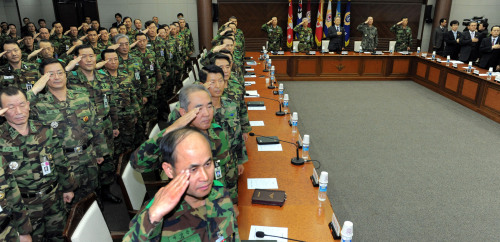Generals are still too attached to decorations, outfits
Withdrawing the plan to detach the star-studded plates from military generals’ sedans has prompted concerns over whether the top brass’ reform drive is eroding.
At the beginning of this year, the Army leadership asked generals to remove the plates ― a longtime symbol of their pride and authority ― displaying its strong resolve to revamp the military.
The plan to remove the plates, which some argued smacked of military authoritarianism, was welcomed by those who criticized the military for its rampant bureaucracy and questionable combat readiness after the two deadly North Korean attacks last year.
However, the measure backfired due in part to objections from retired generals who claim the plates have special meaning, reminding generals of their responsibility as military leaders.
“The star-studded plate has nothing to do with authoritarianism. It exposes the identity of generals wherever they go, making them take responsibility for their deeds and fairly manage their troops,” said Kim In-sik, who retired in 2005 as lieutenant general after having served as commandant of the Marine Corps for two years.
Withdrawing the plan to detach the star-studded plates from military generals’ sedans has prompted concerns over whether the top brass’ reform drive is eroding.
At the beginning of this year, the Army leadership asked generals to remove the plates ― a longtime symbol of their pride and authority ― displaying its strong resolve to revamp the military.
The plan to remove the plates, which some argued smacked of military authoritarianism, was welcomed by those who criticized the military for its rampant bureaucracy and questionable combat readiness after the two deadly North Korean attacks last year.
However, the measure backfired due in part to objections from retired generals who claim the plates have special meaning, reminding generals of their responsibility as military leaders.
“The star-studded plate has nothing to do with authoritarianism. It exposes the identity of generals wherever they go, making them take responsibility for their deeds and fairly manage their troops,” said Kim In-sik, who retired in 2005 as lieutenant general after having served as commandant of the Marine Corps for two years.

The Ministry of National Defense said that the military has decided to have the plates attached for “official events,” explaining that the plates are intended to treat generals with a due level of deference.
“We believe that there are things to maintain in order to treat generals with honor and respect although there is a need to redress their bureaucratic elements,” said an official at the ministry, requesting anonymity.
The reversal of the plan, which has been seen as a litmus test of the military’s avowed commitment to bringing in a genuine reform, apparently frustrated some of the public who wanted to see generals putting themselves at the vanguard of reform efforts.
However, generals still continue to desist from wearing leather belts and zipper combat boots, both of which were unique items distinguishing them from other lower-level soldiers wearing plastic belts and lace-up boots. The military has also decided to offer full-time chauffeurs only to commanding generals or those in positions requiring a high level of mobility.
The controversy over the plates came as generals soul-searched to find ways to shore up public confidence in the military, which has come under fire for its allegedly inadequate responses to the March sinking of the Cheonan and the November artillery attack on Yeonpyeong Island.
During the New Year policy briefing by the ministry on Dec. 29, President Lee Myung-bak upbraided the military for being complacent, urging it to reestablish itself as a stronger combat force.
“The civilians have achieved an immense development while competing with the world in a survival game to advance well into the 21st century. However, the military has become complacent six decades after the end of the (Korean) War. Our generals should be the first to perform better with a strong determination,” Lee said.
Following the president’s remarks, Army Chief of Staff Gen. Kim Sang-ki urged generals to actively engage in the efforts to make the military “battle-ready.”
“The military is an organization that prepares only for a war. We should be aware that it is our mission of the times to transform the military into a battle-ready force by stamping out administrative, wasteful elements that have nothing to do with our combat capabilities,” he said in an email message he recently sent to generals.
In the wake of the two North Korean attacks which together killed 50 South Koreans, the military has vowed to carry out a “high-intensity” reform to refurbish itself into a truly combat-ready force and better deal with North Korean threats.
To address criticism that the military has spent too much time on unnecessary administrative procedures such as preparing documents and briefings, it has decided to reduce paperwork and focus instead on bolstering combat capabilities.
The military is also working on reorganizing its top command structure to enhance interoperability among the three armed services and its capabilities to effectively respond to any emergency situations.
The military has some 430 generals in its 655,000-member forces.
By Song Sang-ho (sshluck@heraldcorp.com)


![[AtoZ into Korean mind] Humor in Korea: Navigating the line between what's funny and not](http://res.heraldm.com/phpwas/restmb_idxmake.php?idx=644&simg=/content/image/2024/04/22/20240422050642_0.jpg&u=)

![[Exclusive] Korean military set to ban iPhones over 'security' concerns](http://res.heraldm.com/phpwas/restmb_idxmake.php?idx=644&simg=/content/image/2024/04/23/20240423050599_0.jpg&u=20240423183955)

![[Herald Interview] Why Toss invited hackers to penetrate its system](http://res.heraldm.com/phpwas/restmb_idxmake.php?idx=644&simg=/content/image/2024/04/22/20240422050569_0.jpg&u=20240422150649)
![[Graphic News] 77% of young Koreans still financially dependent](http://res.heraldm.com/phpwas/restmb_idxmake.php?idx=644&simg=/content/image/2024/04/22/20240422050762_0.gif&u=)






![[Exclusive] Korean military to ban iPhones over security issues](http://res.heraldm.com/phpwas/restmb_idxmake.php?idx=652&simg=/content/image/2024/04/23/20240423050599_0.jpg&u=20240423183955)



![[Today’s K-pop] Ateez confirms US tour details](http://res.heraldm.com/phpwas/restmb_idxmake.php?idx=642&simg=/content/image/2024/04/23/20240423050700_0.jpg&u=)